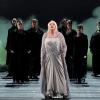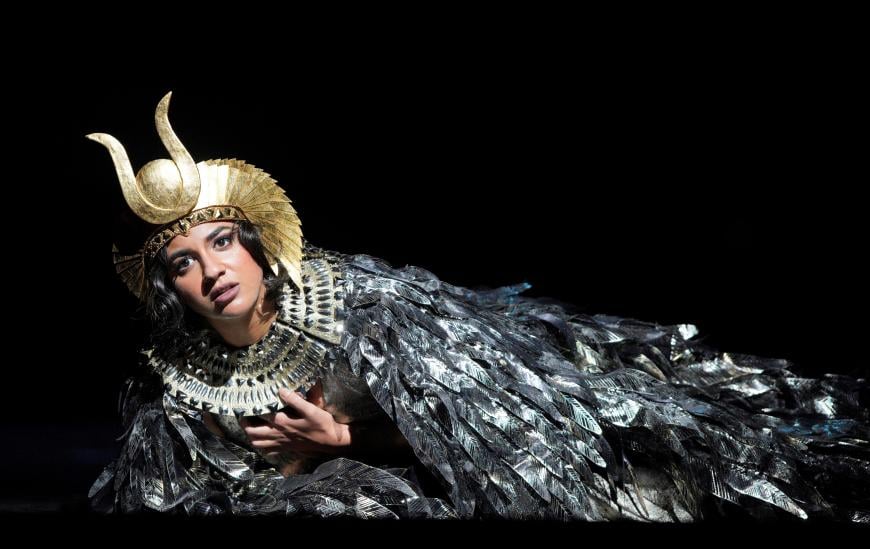
San Francisco Opera’s centennial season is upon us, bringing with it Antony and Cleopatra, a dazzling new opera by John Adams, performed brilliantly on Saturday (Sept. 10) by an outstanding cast and conductor, in a production directed with great dramatic point and force.
It’s long been clear, as I wrote in an earlier review, that Adams responds deeply to the text he’s setting, and that given a great text, he writes great music. A few years ago, Adams read all of Shakespeare’s plays and, commissioned by SF Opera for the centennial season, chose Antony and Cleopatra as the basis of his next opera.
The composer, working with director Elkhanah Pulitzer and dramaturg Lucia Scheckner, has done a masterly job of trimming a sprawling play of some 3,400 lines and 42 characters down to a cogent libretto of manageable length. The libretto focuses on the four central characters, their complicated relationships, and the results of the public and private choices they make. There can be no doubts about the greatness and beauty of this text, a meditation on love, politics, and the chaos that can result when the two intersect.
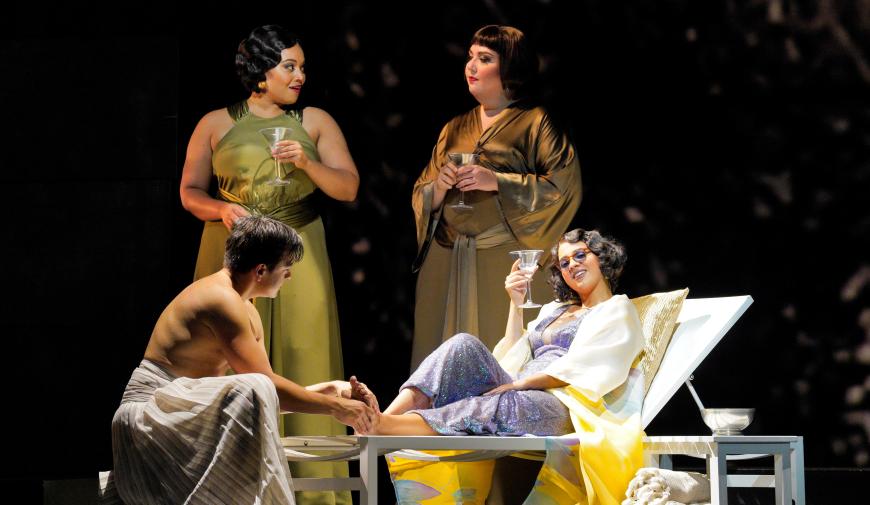
Pulitzer and the creative team, including set designer Mimi Lien and costume designer Constance Hoffman, have updated the setting to reflect cinematic Hollywood in the 1920s and 30s. Cleopatra and her attendants wear Art Deco-tinged garments in sumptuous fabrics; the men are largely in modern military uniforms, with Antony in a decadent robe in the opening scene.
Lien’s spacious and crisply geometric sets suggest pyramids, monuments, bedrooms, and offices, as much with negative spaces as with the sets themselves, all beautifully lit by David Finn. Projection designer Bill Morrison combines historic 1930s black-and-white film with new video, much of it sepia, to vividly create a sense of glamour and historic parallels between ancient times, the 1930s, and the modern world.
Leading the cast as the titular lovers are bass-baritone Gerald Finley and soprano Amina Edris. Edris joined the cast just two months before rehearsals started. In a star-is-born turn, she has made the long and complex role of Cleopatra, planned for Julia Bullock, sensationally and entirely her own.
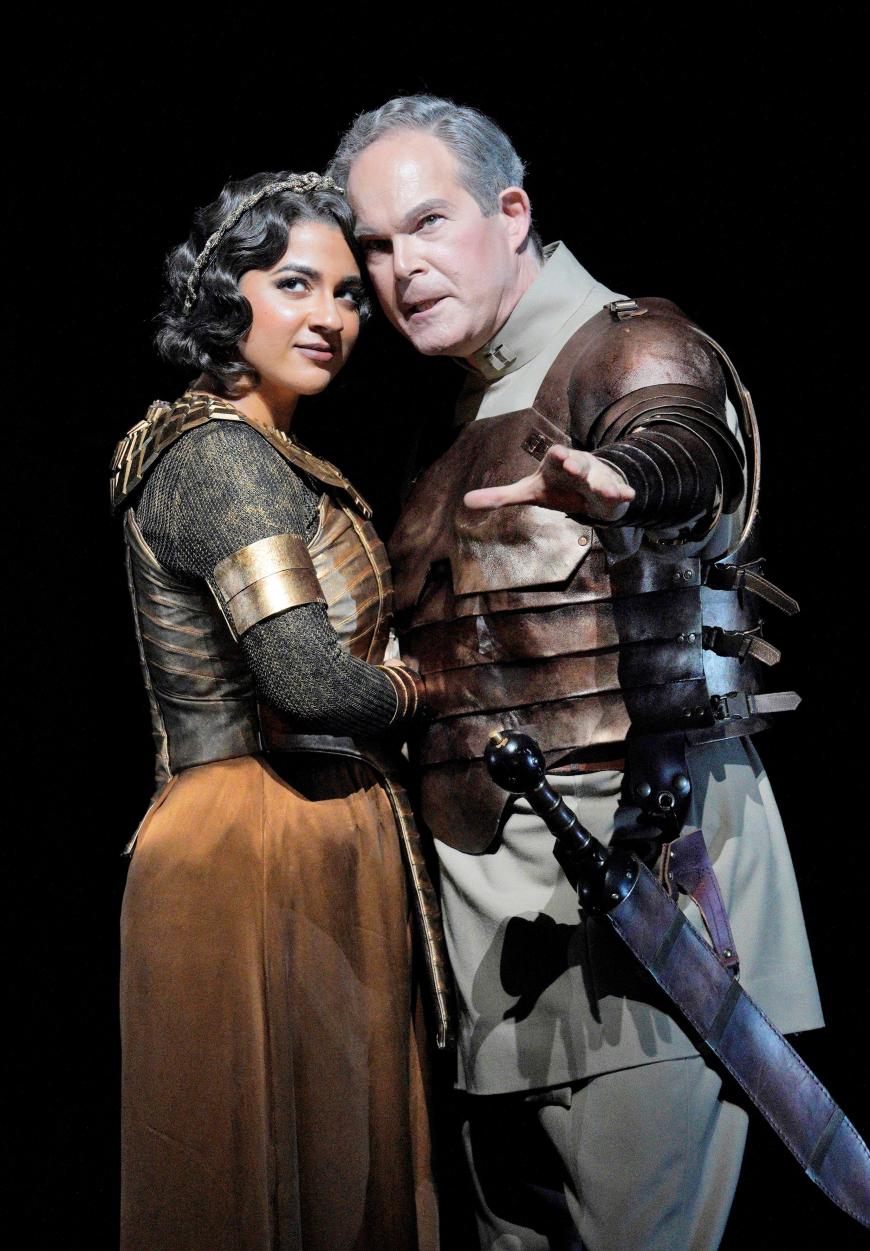
She brings an agile, distinctive voice with a warm middle register and glittering high notes to the part. Moreover, her personal beauty and dynamic stage personality make her a superb fit in a production built around the glamour of Hollywood. She is Cleopatra, ruler of Egypt and Antony’s heart, imperious, commanding, and sometimes impulsive, whether she’s flirting with a tipsy night-after Antony, rounding on a messenger delivering an unwanted message, or standing up to Caesar’s minions.
Finley last appeared at SFO in 2005, when he originated the role of J. Robert Oppenheimer in Adams’s Doctor Atomic. At 62, he’s an Adams veteran, and it shows in his natural, lieder-like delivery. His voice has hardly changed in the last 17 years, retaining its smooth production and beauty. Antony is a passionate lover, a worn and overconfident leader, a man whose decisions aren’t always wise. Finley embodies all of this with ease. Together, Edris and Finley make a tempestuous pair, hurtling blindly toward their own destruction.
Tenor Paul Appleby is a stunning Octavian, the future Caesar Augustus, making of him an emotional, yet calculating, political animal. He’s terrifying in the long Act 2 scene in which he extolls Roman expansion into empire. He sings from a cutout above the stage, surrounded by video of his own head, multiplied, and of 1930s crowds, with the chorus below onstage. The only misstep in the physical production is that Octavian is consistently, mockingly referred to as “the young man,” but Appleby doesn’t look youthful enough to be in his 20s. Regardless, one can’t help but compare Octavian’s demagoguery with the would-be dictators of today.
Mezzo-soprano Elizabeth DeShong sings so beautifully in the small role of Octavian’s sister Octavia, whom Antony marries for political reasons, that you wish the role were bigger so that you could hear more of her. Alfred Walker is Antony’s stalwart lieutenant Enobarbus, by his side and always supportive. Mezzo-sopranos Taylor Raven and Gabrielle Beteag brought calm nobility and striking voices to Cleopatra’s attendants Charmian and Iras.
Brenton Ryan (Eros), Hadleigh Adams (Agrippa), Patrick Blackwell (Maecenas), Philip Skinner (Lepidus), and Timothy Murray (Scarus) all sang superbly and made strong dramatic impressions in the shorter roles that bind together the plot.
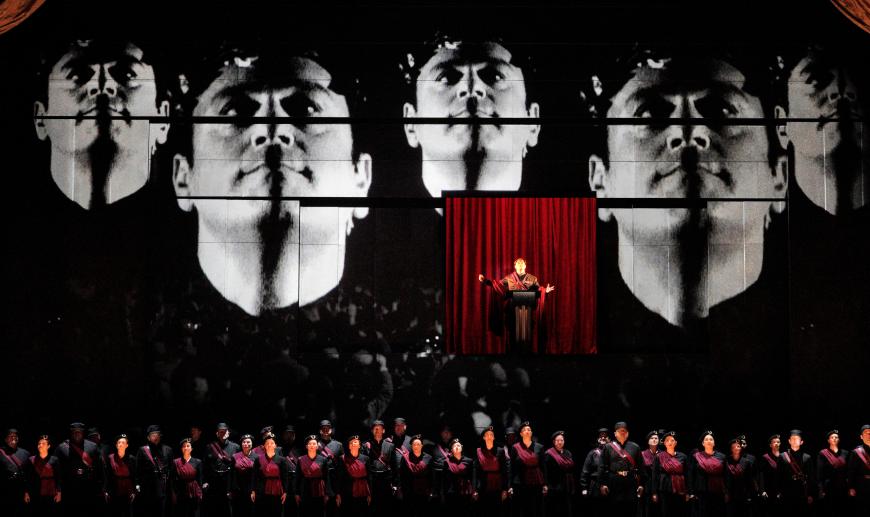
Like any successful dramatic production, Antony is a great team effort. Bringing it all together is Pulitzer’s direction of the singers, which flows through the production as naturally as the Nile. She stages each scene without affectation or eccentricity, following and supporting the flow of words and music and, of course, the relationships among the characters. Everything onstage — singers, sets, lighting — works together with an organic sense of rightness.
Adams’s score is a miraculous summation of the best of his work over the last 30-plus years. The syncopation, swirling winds, ominous brass, and sinister percussion are all characteristic. Antony’s orchestra has its own special coloration, incorporating a quartet of instruments whose sound permeates the whole opera: two harps, a celesta (think sugar plum fairies), and a cimbalom, a card table-sized hammered dulcimer (think Igor Stravinsky’s Ragtime). The cimbalom, unusual in a Western orchestra, is most closely associated with the scenes in Egypt. Special kudos for their great work to Chester Englander on cimbalom, Laura Poe on celesta, and harpists Annabelle Taubl and Jieyin Wu.
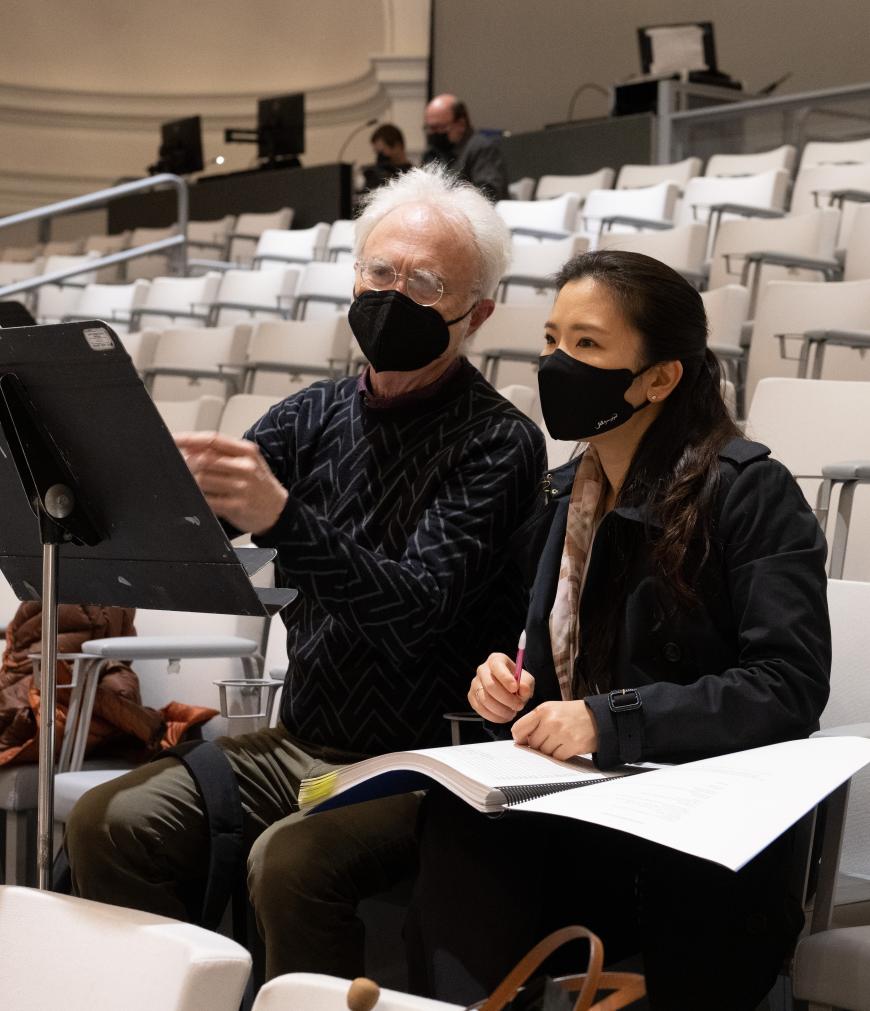
The orchestration is magnificently detailed and also exceptionally sensitive to the singers’ needs, composed around the vocal lines and never competing with them. Adams cuts loose with more heavily orchestrated music in the vibrant interludes separating scenes in Rome and Alexandria. The music for the long and brilliantly staged Battle of Actium sequence is particularly striking and starts off with what seems to be a long allusion to the watery opening of Das Rheingold. Each character’s personality is reflected in the music he or she sings: Cleopatra’s lines are spiky and wide-ranging, Antony’s more solid and rooted. Caesar’s music is full of tension as “the young man” establishes himself and his position. And Adams gives Antony and Cleopatra magnificent death scenes, including a heartrending duet while Antony lays dying.
All this was executed on opening night with the greatest flair by the cast and by Music Director Eun Sun Kim, who hadn’t conducted any Adams before this. The orchestra was in magnificent form, sounding glorious and facing down the myriad technical challenges of the score with aplomb. The ensemble’s unanimity is especially notable given the surprising number of acting principals and season substitutes listed in the program. As well, the chorus, appearing briefly in a few scenes, was in great voice and sang precisely under recently appointed Chorus Director John Keene. Adams uses the chorus to comment on and reflect the action and what the characters are saying, very much a Greek chorus in a Roman-Egyptian work.
Despite its strengths, the libretto does present some difficulties. The complex syntax and allusions of Shakespearean English take most modern audience members some time to understand. The play is talky and so is the opera, in which Adams’s text-setting follows the natural rhythms of the English language, a style not far off from Leoš Janáček’s.
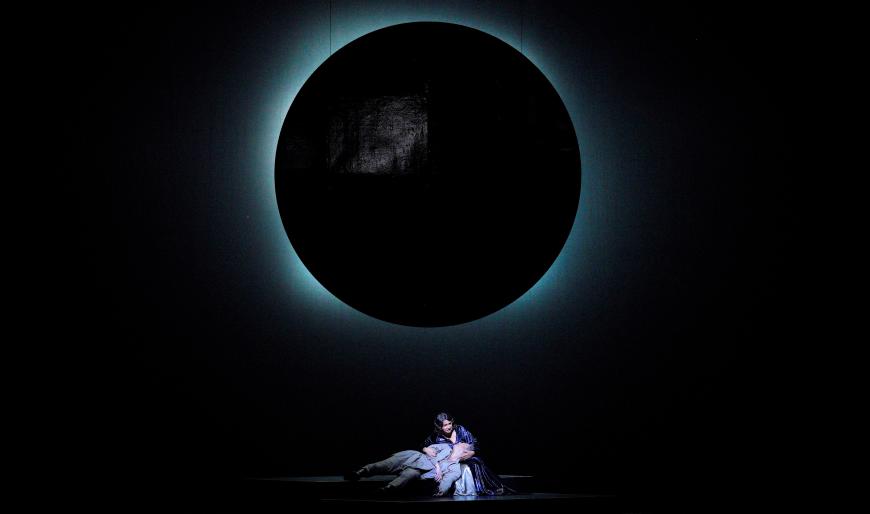
The words come at you hard and fast, and sometimes you wish Adams would linger more on important words and phrases. The cast’s delivery of the text varies over the course of the performance and from singer to singer. Despite the excellence of the sound enhancement system and Mark Grey’s sound design — mostly you can’t tell there’s any enhancement — the complex text doesn’t come through clearly enough. The supertitles are far above the stage, meaning the audience’s eyes, and attention, must constantly switch from action to projection. If ever a production called for stage-level titles, this is it, and the regular presence of flat black panels in the sets means it might even have been possible.
After the disappointments of Adams’s last opera, 2017’s Girls of the Golden West, Antony and Cleopatra represents a return to top form by one of our most important composers. Deepest congratulations are due all who contributed to these performances, and we can but hope that Adams will write more operas of this quality in the years to come.




